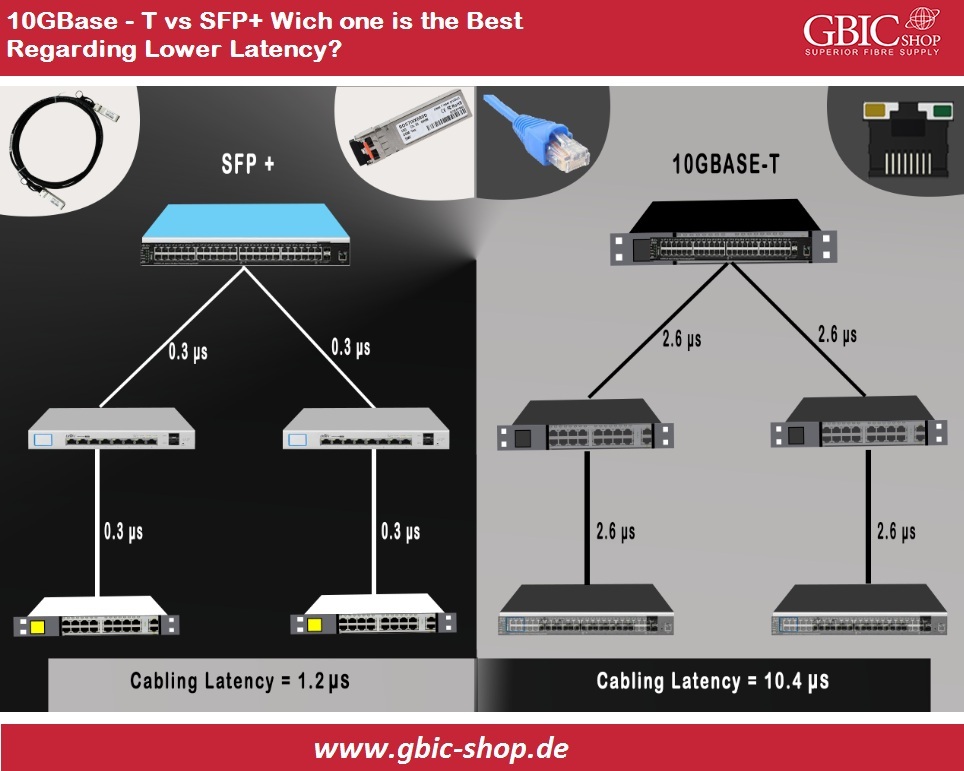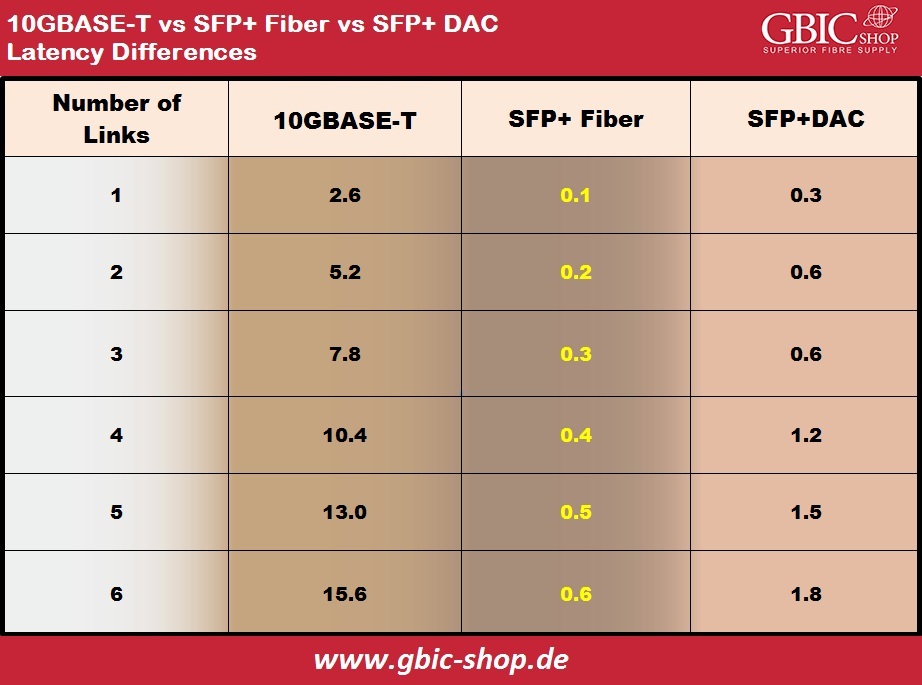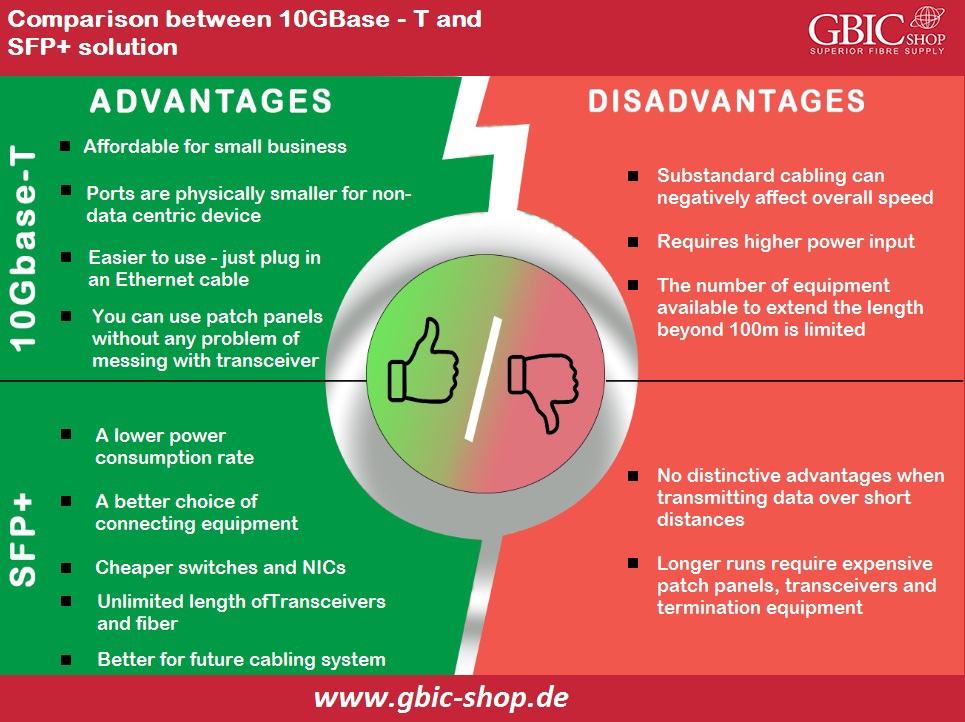While planning a modern network structure that ought to be the architect on 10 gigabit Ethernet, we will have to select the suitable implements to obtain the best presentation and support the future complicated, complicated requirements network implementations.

We have two choices for 10 gigabit Ethernet connection: SFP+ Solution and 10GBASE-T. Copper module 10GBASE-T can stretch network connection above 100m over Category 6a/Category 7 wires. SFP+ optical fibers will support above 300m on multimode optical fiber, and single-mode optical fiber will help more than 80 kilometers. Moreover, SFP+ AOC/DOC wires are best for implementing blade chassis and 10 gigabit Ethernet in the framework above short spans, for example, 3 meters 5 meters, 7 meters 15 meters, and over 30 meters.
DIFFERENCES BETWEEN SFP+ OPTIC FIBER, 10GBASE-T, AND SFP+ DAC:
The differences among SFP+ optical fiber transceivers, 10GBASE-T module, and SFP+ DAC can be discussed in detail under the following headings.
LATENCY:
Lower latency is significant for making a specific quick response time and decreasing idle CPU cycles, extending data center capability and copper modules ROI. 10GBASE-T chooses a physical layer standard to utilize block encryption to transfer data around the copper wires without any mistake. The standard PHY determines 2.6 microseconds for a transfer-receive set. Moreover, the diameter of the block demands that latency should be less than 2 microseconds. SFP+ utilizes uncomplicated electronics without any encryption, and its regular latency is about 300ns per connection. We can observe from the given chart that SFP+ optical fiber presents lower latency than the other two products.

POWER UTILIZATION:
The solution 10GBASE-T uses more power in comparison to SFP+ solutions. The use of the power of 10GBASE-T relies on the range of the wire, and it may extend from 2 up to 5W per port at every ending of the wire. Furthermore, SFP+ uses the power of about 0.7W per port irrespective of the range of wire. A significant difference is realizing that we see thousands of wires fixed within a particular data center, which would preserve enough money if SFP+ is utilized.
BACKWARD ADAPTABILITY:
The copper wiring 10GBASE-T is backward adaptable productively with typical copper structure appliances, which can enhance the usage of current copper designed wiring. By Utilizing the RJ45 joiner, the port 10GBASE-T connects to 1GB and 100Mb interfaces. We cannot use DACs to communicate to legacy apparatus, and it can only use it for switches of 10 Gigabit Ethernet. But, SFP 1GB optical transceivers can be put into ports SFP+ and will operate at 1GB, connecting to legacy ports above fiber wire. SFP modules providing support to 1GBASE-T may also be put to link to legacy ports toward lower speeds.
IMPLEMENTATION:
10GBASE-T SFP+ is mainly used for the cabling closet comprised of switches or patch panels which give connectedness to a high populace of desktop computers for 10 meters. For HPC and data centers, the comforts of DAC SFP+ are of high compatibility for present day’s demands and rising tendencies. They have generally utilized for TOR inter-cabinet connectedness for switches from servers to TOR in 10 meters; for example, they are interrelated with switches TOR and servers, moreover, between storage appliances in or adjoining racks. SFP+ transceivers are usually implemented for campus networks to bind different buildings, generally extending over large ranges.
PRICE:
SFP+ elements are cost-effective presently per port, $20 or lesser. The fiber wires are also cost-effective, reaching the prices of Category 6a wires and lowering in price when the volume quickly increases. The general solution price is now wholly reasonable with lessening 10GB SFP+ switches costs, NIC prices, and DAC prices. Per-port price of 10GBASE-T is near $50 to $100. 10GBASE-T is getting into mass production with 40nanometer, and the price will lessen gradually. Moreover, 10GBASE-T has backward adaptability with 1 Gigabit port, which uses various fewer bandwidth appliances. 10GBASE-T is usually inexpensive and uncomplicated to use in comparison to the other option, SFP+, for work of small industries.
FINAL PROPOSALS:
If expandability and flexibility are significant in implementing your small industry work, then 10GBASE-T wiring is the best option. But, if power utilization and low latency are essential, then 10G SFP+ wiring will be the right choice. Both have their benefits, and you can make selections as per your network.

 English
English
 Deutsch
Deutsch
 Espaniol
Espaniol










